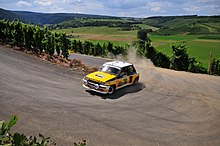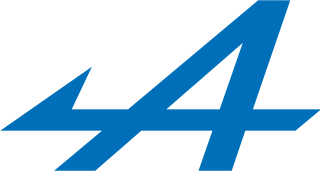
The Société des Automobiles Alpine SAS, commonly known as Alpine, is a French manufacturer of sports cars and racing cars established in 1955. The Alpine car marque was created in 1954.

The Peugeot 205 is a supermini (B-segment) car produced by the French manufacturer Peugeot from 1983 to 1999.

The Ford RS200 is a mid-engined, all-wheel-drive sports car that was produced by Ford Motorsport in Boreham, UK, from 1984 to 1986. The road-going RS200 was the basis for Ford's Group B rally car and was designed to comply with FIA homologation regulations, which required 200 parts kits to be produced and at least one road-legal car to be assembled. It was first displayed to the public at the Belfast Motor Show.

The Renault Clio is a supermini (B-segment) car, produced by French automobile manufacturer Renault. It was launched in 1990, and entered its fifth generation in 2019. The Clio has had substantial critical and commercial success, being consistently one of Europe's top-selling cars since its launch, and it is largely credited with restoring Renault's reputation and stature after a difficult second half of the 1980s. The Clio is one of only two cars, the other being the Volkswagen Golf, to have been voted European Car of the Year twice, in 1991 and 2006.
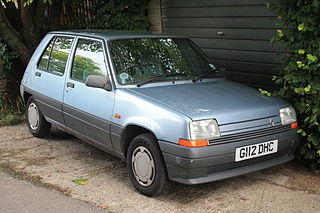
The Renault 5 is a five-passenger, three or five-door, front-engine, front-wheel drive hatchback supermini manufactured and marketed by the French automaker Renault over two generations: 1972–1985 and 1984–1996.

The Renault 9 and Renault 11 are small family cars produced by the French manufacturer Renault from 1981–1988 in saloon and hatchback configurations — both were styled by the French automobile designer, Robert Opron.
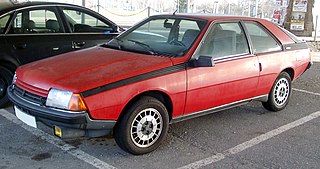
The Renault Fuego is a sport hatchback that was manufactured and marketed by Renault from 1980 to 1986, replacing the Renault 15 and 17 coupés of the 1970s.

Group B was a set of regulations for grand touring (GT) vehicles used in sports car racing and rallying introduced in 1982 by the Fédération Internationale de l'Automobile (FIA). Although permitted to enter a GT class of the World Sportscar Championship alongside the more popular racing prototypes of Group C, Group B are commonly associated with the international rallying scene during 1982 to 1986 in popular culture, when they were the highest class used across rallying, including the World Rally Championship, regional and national championships.

The Renault 16 (R16) is a D-segment family hatchback manufactured and marketed over a single generation by French automaker Renault between 1965 and 1980 in Le Havre, France — and widely noted as the first French winner of the European Car of the Year award.
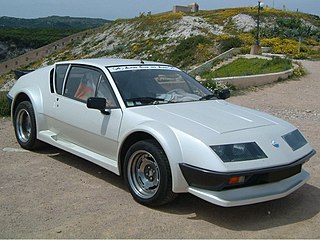
The Alpine A310 is a sports car built by French manufacturer Alpine, from 1971 to 1984.

The Fiat 124 Sport Spider is a convertible sports car marketed by Fiat for model years 1966–1985. Designed by and manufactured at the Italian carrozzeria Pininfarina factory, the monocoque, front-engined, rear-drive Sport Spider debuted at the November 1966 Turin Auto Show with styling by Tom Tjaarda.

The Alpine A110 is a sports car produced by French automobile manufacturer Alpine from 1963 to 1977. The car was styled as a "berlinette", which in the post-WWII era refers to a small enclosed two-door berline, better-known as a coupé. The Alpine A110 succeeded the earlier A108. The car was powered by a succession of Renault engines. A car also named Alpine A110 was introduced in 2017.

The Renault 20(R20) and Renault 30(R30) are two executive cars produced by the French automaker Renault between 1975 and 1984. The most upmarket and expensive Renaults of their time, the two cars were almost identical with regard to sheet metal and mechanicals; the R30 was the larger-engined and more expensive of the two. The two cars were easily distinguished between each other from their differing headlight configuration – the Renault 20 had two single rectangular headlights, whereas the Renault 30 had quadruple round headlights. The interior specifications differed substantially, however, with the Renault 30 having a higher specification in all models. Over 622,000 R20s and 145,000 R30s were produced in Sandouville near Le Havre, France.

The Renault 18 is a large family car produced by French manufacturer Renault between 1978 and 1989, with South American production continuing until 1994. It formed the basis for the closely related Renault Fuego Coupé, with which it shared its floorpan and drivetrain, but with the Fuego initially using the negative offset type front suspension from the larger Renault 20/30, which became standardized across the 18 range from the 1983 model year onwards.

Jean "Jeannot" Ragnotti, is a French former rally driver for Renault in the World Rally Championship.
The Renault Alpine GTA and the succeeding A610 is a sports coupe automobile produced by the Renault-owned French manufacturer Alpine between late 1984 and 1995. It replaced the slow-selling Alpine A310, with which it shared many features, including the layout and engine. The GTA was replaced by the A610 in 1991.

The Alfa Romeo Alfetta is a front-engine, five-passenger sedan and fastback coupé manufactured and marketed by Alfa Romeo from 1972 to 1987 with a production total over 400,000.

The Cléon-Fonte engine is a family of inline four-cylinder automobile engines developed and manufactured by Renault. It has also been called the Sierra engine, the C-engine, or the C-Type. It has been in continuous production by Renault or a licensee from 1962 to 2004. After about three decades of use in Renault's compact models, it was gradually replaced by the E-type engine from the late 1980s onward.

Group Rally2 is a technical specification of rally car determined by the FIA. It features 1.6L turbo engines, four-wheel drive and a maximum power-to-weight ratio of 4.2kg/hp. Rally2 cars are used in the World Rally Championship and continental championships; a few national rallying competitions also allow Group Rally2 cars to compete. The group was launched in 2019 with other similarly named groups after the introduction of the Rally Pyramid initiative to reorganise the classes of car and championships in international rallying was approved in June 2018.

Group Rally4 is a technical specification of rally car determined by the FIA for use in its international competitions: World Rally Championship (WRC) and regional championships. National rallying competitions also allow Group Rally4 cars to compete. There are two technical subclasses of Group Rally4 however these do not affect competitive eligibility. 'Rally4' may be used alone with the same definition. The group was launched in 2019 after the introduction of the Rally Pyramid initiative to reorganise the classes of car and championships in international rallying was approved in June 2018.




